Themed collection Liquid Crystals Science and Technology

Grafting of thermotropic fluorinated mesogens on polysiloxane to improve the processability of linear low-density polyethylene
A series of polysiloxane grafted with thermotropic fluorinated mesogens (TSCPFLCP) is designed and synthesized, which effectively improves the processability and toughness of LLDPE.

RSC Adv., 2022,12, 12463-12470
https://doi.org/10.1039/D2RA01482C
Effects of liquid crystal polymer (LCP) on the structure and performance of PEEK/CF composites
Here a liquid crystal polymer (LCP) was introduced into a PEEK/CF system as a new solution to simultaneously promote processing and mechanical performance of PEEK/CF and other polymer-based composites.
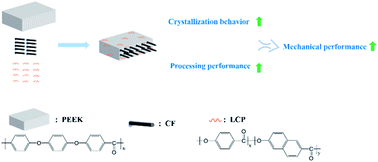
RSC Adv., 2022,12, 12446-12452
https://doi.org/10.1039/D2RA01450E
Influence of hydroquinone content on thermotropic liquid crystalline copolymers and nanocomposites: thermo-mechanical properties and morphology
Thermotropic liquid crystalline copolyesters (Co-TLCPs) were synthesized by varying the hydroquinone (HQ) molar ratio from 1–5 with respect to the 2,5-diethoxyterephthalic acid (ETA) monomer.
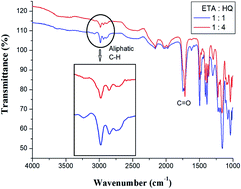
RSC Adv., 2022,12, 8852-8861
https://doi.org/10.1039/D2RA00795A
Preparation of substituted triphenylenes via nickel-mediated Yamamoto coupling
Nickel-mediated Yamamoto coupling provides a concise and efficient synthesis of triphenylene derivatives, including electron-deficient discotic mesogens.

RSC Adv., 2021,11, 39564-39569
https://doi.org/10.1039/D1RA07931J
Multifunctional sensors based on liquid crystals scaffolded in nematic polymer networks
Naked-eye color change as a result of temperature change or VOC exposure was demonstrated in a nematic polymer network-stabilized liquid crystal (PNLC) system.

RSC Adv., 2021,11, 38694-38702
https://doi.org/10.1039/D1RA08030J
Liquid crystal behavior, photoluminescence and gas sensing: A new series of ionic liquid crystal imidazole and benzoimidazole bearing chalcone groups, synthesis and characterization
Four new series of chalcones containing imidazole bromonium and benzimidazole bromonium salts with spacer alkyl chains (Cn, n = 2 and 4) were synthesized and their chemical structure, thermal behavior, photoluminescence and gas sensing ability were characterized.

RSC Adv., 2021,11, 38444-38456
https://doi.org/10.1039/D1RA07731G
Optical anticounterfeiting photonic bilayer film based on handedness of solid-state helicoidal structure
Anticounterfeiting photonic bilayer DH-CLCsolid films were fabricated by sandwiching two CLCsolid films having different handedness. The encrypted information is only disclosed under right-handed circular polarized light.

RSC Adv., 2021,11, 37498-37503
https://doi.org/10.1039/D1RA07021E
Novel sulphonic acid liquid crystal derivatives: experimental, computational and optoelectrical characterizations
A novel liquid crystal homologous series based on the benzene sulphonic acid moiety, namely (E)-4-((4-((4-(alkoxy)benzoyl)oxy)benzylidene)amino)benzenesulfonic acid (Sn), was synthesized and examined via different experimental and theoretical measurements.

RSC Adv., 2021,11, 27937-27949
https://doi.org/10.1039/D1RA02517A
Ultraviolet light screen using cholesteric liquid crystal capsules on the basis of selective reflection
When the prepared cholesteric liquid crystal microcapsule is applied to the skin, it can protect the skin by selectively reflecting only ultraviolet rays in sunlight like sunscreen cosmetics.

RSC Adv., 2021,11, 25471-25476
https://doi.org/10.1039/D1RA03499E
Preparation of graphene oxide liquid crystals with long-range highly-ordered flakes using a coat-hanger die
Graphene oxide liquid crystals with long-range highly ordered GO flakes were successfully prepared by a designed coat-hanger die.
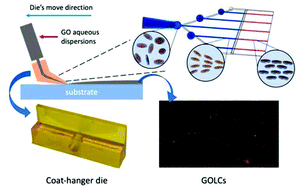
RSC Adv., 2021,11, 15085-15090
https://doi.org/10.1039/D1RA01241J
Cholesteric mesophase based 1D photonic materials from self-assembly of liquid crystalline block and random terpolymers containing chromonic molecules
We describe the influence of competing self-organizing phenomena on the formation of cholesteric mesophase in liquid crystalline brush block terpolymers (LCBBTs) and liquid crystalline random brush terpolymers (LCRBTs) containing chromonic molecules.

RSC Adv., 2021,11, 14615-14623
https://doi.org/10.1039/D1RA00899D
Gold nanoparticles grafted with chemically incompatible ligands
A Janus-type lamellar structure is formed from gold nanoparticles grafted with chemically incompatible mesogenic ligands. Metallic NP-rich sublayers are separated by ligand-rich sublayers of various composition due to the ligand segregation.
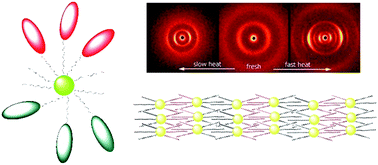
RSC Adv., 2021,11, 9568-9571
https://doi.org/10.1039/D1RA00547B
The role of intermolecular interactions in stabilizing the structure of the nematic twist-bend phase
Stabilization of the nematic twist-band phase by arrays of multiple nonspecific short-range intermolecular interactions.

RSC Adv., 2021,11, 2917-2925
https://doi.org/10.1039/D0RA10481G
Directional effect on the fusion of ellipsoidal morphologies into nanorods and nanotubes
Herein, a directional fusion of ellipsoidal morphologies into nanorods and nanotubes was demonstrated through the study of polymerization-induced self-assembly behaviors of semi-fluorinated liquid-crystalline block copolymers.
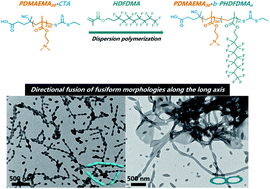
RSC Adv., 2021,11, 1729-1735
https://doi.org/10.1039/D0RA09548F
Patterned waveguide liquid crystal displays
A polymer stabilized LC based light waveguide display is reported. Performance is improved by patterned photo-polymerization or electrode. It has high brightness, ultrafast switching time, high contrast ratio, and high transmittance for transparent and augmented displays.

RSC Adv., 2020,10, 41693-41702
https://doi.org/10.1039/D0RA07016E
Organic–inorganic hybrid liquid crystals of azopyridine-enabled halogen-bonding towards sensing in aquatic environment
Organic–inorganic hybrid liquid crystals of azopyridines enabled by halogen bonding with the triple functions of degree of orientation change, MEF, and SERS towards sensing silver in aquatic environment.
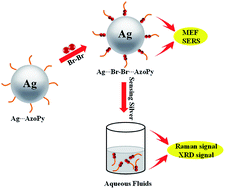
RSC Adv., 2020,10, 35873-35877
https://doi.org/10.1039/D0RA06838A
Polymer-dispersed liquid-crystal-based switchable glazing fabricated via vacuum glass coupling
A vacuum-coupling technique is suggested to fabricate a glass-based PDLC, without using a roll-to-roll process, to improve the optical properties.
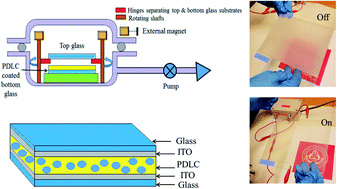
RSC Adv., 2020,10, 32225-32231
https://doi.org/10.1039/D0RA05911K
Synthesis of novel liquid crystalline and fire retardant molecules based on six-armed cyclotriphosphazene core containing Schiff base and amide linking units
The FTIR spectra overlay of compounds 5a–j with Schiff base and amide linking units.
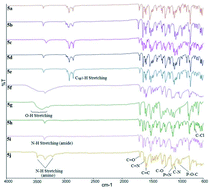
RSC Adv., 2020,10, 28918-28934
https://doi.org/10.1039/D0RA03812A
Textile materials inspired by structural colour in nature
The concept of mimicking structural colour in nature as an alternative to traditional textile coloration techniques would reduce dependency on dyes, pigments and vast quantities of water in the textile supply chain.

RSC Adv., 2020,10, 24362-24367
https://doi.org/10.1039/D0RA01326A
Fluorenone imidazolium salts as novel de Vries materials
ILCs consisting of cationic head group–spacer–fluorenone central core–side chain show de Vries-like behaviour.
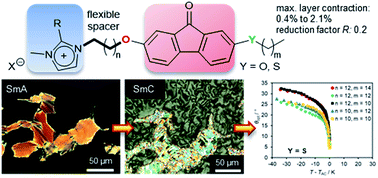
RSC Adv., 2020,10, 23999-24016
https://doi.org/10.1039/D0RA04650G
Difference in the interaction of nano-diameter rod and tubular particles with a disclination line in a nematic liquid crystal
The liquid crystal forces generated by nanowires and nanotubes are different due to their heterotopicity for the liquid crystal director.
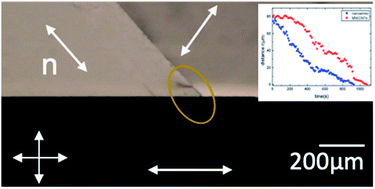
RSC Adv., 2020,10, 21473-21480
https://doi.org/10.1039/D0RA01525C
Photo-controllable rotational motion of cholesteric liquid crystalline droplets in a dispersion system
A photo-controllable rotational motion was demonstrated for an isolated cholesteric liquid crystalline droplet in a surfactant solution.

RSC Adv., 2020,10, 21191-21197
https://doi.org/10.1039/D0RA03465G
One-pot synthesis of symmetric imidazolium ionic liquids N,N-disubstituted with long alkyl chains
The modified Debus–Radziszewski reaction was used as a one-pot on-water reaction to allow a greener synthesis of long-chain 1,3-dialkylimidazolium acetate ionic liquids in high yield from long-chain linear amines.

RSC Adv., 2020,10, 21071-21081
https://doi.org/10.1039/D0RA03358H
Influence of inter- and intramolecular H-bonding on the mesomorphic and photoswitching behaviour of (E)-4-((4-(hexyloxy)phenyl)diazenyl)-N-phenyl benzamides
We report on the synthesis, phase behaviour and photoswitching studies of new azo linked rod-shaped molecules.

RSC Adv., 2020,10, 20222-20230
https://doi.org/10.1039/D0RA03024D
Facile control of surfactant lamellar phase transition and adsorption behavior
The presence of small water-soluble additives makes it possible to tune the surfactant gel-to-liquid crystalline (Lβ–Lα) phase transition temperature (Tm) for a bilayer-forming cationic surfactant system and its phase behavior on dilution.

RSC Adv., 2020,10, 18025-18034
https://doi.org/10.1039/D0RA01340D
Hexahydrofarnesyl as an original bio-sourced alkyl chain for the preparation of glycosides surfactants with enhanced physicochemical properties
The novelty of this work lies in the valorization of an original by-product into new sugar-based surfactants presenting effective properties.

RSC Adv., 2020,10, 16377-16389
https://doi.org/10.1039/D0RA02326D
L-DOPA modulates the kinetics but not the thermodynamic equilibrium of TTA+ amphiphiles forming lyotropic nematic liquid crystals
L-DOPA modulates the dive in mechanism of bicelles with potential use as drug delivery systems.
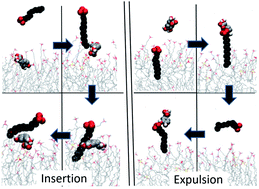
RSC Adv., 2020,10, 15366-15374
https://doi.org/10.1039/D0RA00764A
Hybrid fluorescent liquid crystalline composites: directed assembly of quantum dots in liquid crystalline block copolymer matrices
Spatial distribution of QDs within hybrid composite films was programed by varying the molecular architecture of the host LC block copolymers.

RSC Adv., 2020,10, 15264-15273
https://doi.org/10.1039/D0RA02442B
New wide-stability four-ring azo/ester/Schiff base liquid crystals: synthesis, mesomorphic, photophysical, and DFT approaches
DSC thermograms of some prepared compounds: (a) recorded from second heating and (b) from cooling at a rate of ±10 °C min−1.
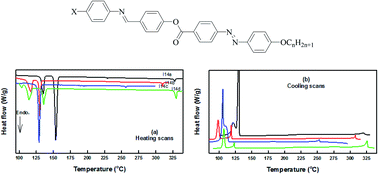
RSC Adv., 2020,10, 9643-9656
https://doi.org/10.1039/C9RA10499B
Reversible photo-responsive gel–sol transitions of robust organogels based on an azobenzene-containing main-chain liquid crystalline polymer
A robust and photo-responsive organogel has been constructed by introducing an azobenzene-containing main-chain liquid crystalline polymer gelator.

RSC Adv., 2020,10, 3726-3733
https://doi.org/10.1039/C9RA10161F
Defect-mediated colloidal interactions in a nematic-phase discotic solvent
Saturn ring dyads (left) mediate more stable colloidal interactions than Saturn ring triads (right) in nematic-phase discotic dispersions.
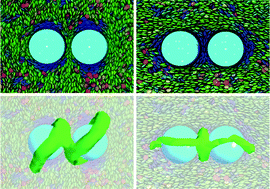
RSC Adv., 2019,9, 33413-33427
https://doi.org/10.1039/C9RA05377H
About this collection
Welcome to this themed collection on “Liquid Crystals Science and Technology”, guest edited by Dr Giacomo Saielli (Italian National Research Council and University of Padova).
Liquid Crystals (LCs) have been discovered serendipitously in 1888 by the botanist Friedrich Reinitzer. Their discovery sparked a great deal of debate during the first half of 1900 concerning their structural and dynamic properties and even their relationship with living organisms. They remained, however, mostly an academic curiosity until the second half of the last century when their possible application as displays became clear.
LC displays now represent a huge share of the display industry and many other applications based on LCs have been proposed and developed. At the same time, the LC science, mostly rooted in chemistry and physics but also touching mathematics, biology and engineering, has progressed significantly with new fields opening, e.g. ionic liquid crystals, polymeric liquid crystals, active matter systems, orienting phases for bio-NMR, LC-based membranes for separation. Moreover, new LC phases have been reported during the last recent decades renewing the scientific discussion on the fundamental properties and phase structure of these fascinating materials.
This themed collection highlights a series of papers published in the last two years concerning basic scientific investigations on LCs, from the synthesis of novel materials to structure-property relationships as well as applications in opto-electronic devices, thus attesting the breadth and vitality of the present research on liquid crystals.